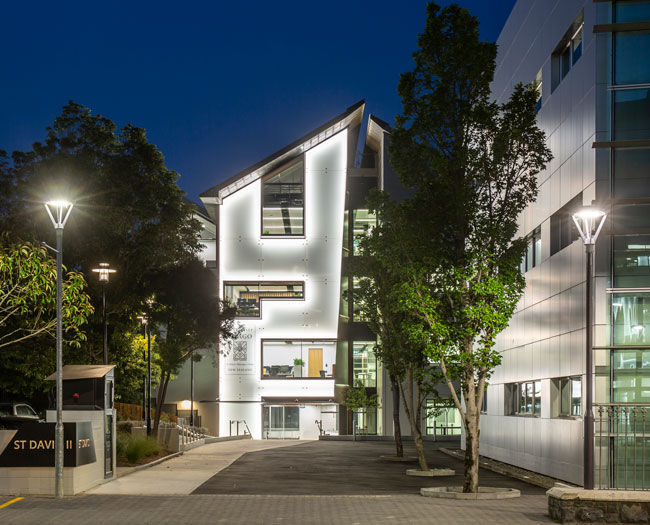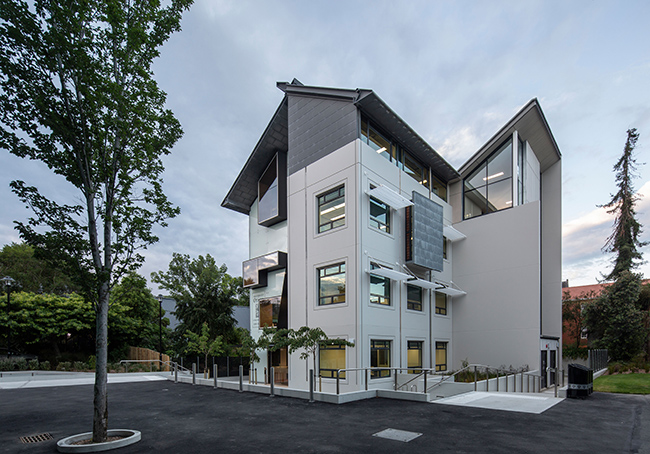
St David II aglow at night.
This $8.9 million redevelopment resurrected a vacant University of Otago building, producing a showcase and benchmark for open plan offices on the campuses.
The redevelopment will ultimately reduce the University's use of leased premises.
The backbone
Glass-fronted quiet rooms along a central 'spine' provide sound-treated areas for discussions, break-out meetings, study and phone calls – some of those rooms and larger meeting rooms can open up completely to the open plan offices
Having central rooms creates maximum space for the flanking open plan areas where staff are located, which are beside large windows where light flood inside. A special type of glazing has been added to all existing single-glass windows to prevent over-heating or heat loss affecting people beside the windows.
The flexible open plan spaces are enhanced with modular furniture that is easily moved to meets changing needs.
More sound treatment
Hand-finished acoustic ceiling panels (350) not only absorb sound, but also create interest by being suspended beneath visible service pipes.
All carpet tiles have acoustic backing to absorb sound, and varying colours to define floors, circulation spaces, offices and meeting rooms.
Peaceful plants
The University bought about 200 peace lily plants for the top of storage lockers to provide screening, absorb carbon dioxide, add oxygen to the air and help remove any pollutants.
Studies by Dr Bill Wolverton – who worked with NASA for years studying indoor plants for air purifying properties – discovered peace lilies were among the best for removing pollutants such as formaldehyde, benzene, alcohols, acetone that can be found in paints, varnishes, carpet glues, electronics and adhesives etc.
The peace lilies also have a high transpiration rate – they pumps moisture into often dry indoor.
Unique
Some other firsts for the University with this project include:
- 'Follow-me' printing that lets St David II occupants use any campus printer from the building
- The entire building having Voice over Internet Protocol (VoIP) phones - staff no longer have to log requests for phones to be moved, they can just log on to any phone in the building. This system costs less to set-up and use than traditional phone systems
- A lift that 'speaks' Māori and English
- Exterior lights that create patterns – lines of light – on the western façade
- A private outdoor area that includes a picnic table for staff

St David II on a clear morning.
Overview
This project included creating:
- A new front entrance and reception area
- Open plan offices (16)
- Break-out and study areas (18)
- Four large meeting rooms (for between eight and 24 people)
- Reconfigured toilets and showers – accessible on every floor
- Kitchenettes, every floor
- Interview rooms
- A baby changing room
- Staff lockers
- Internal stairs replacing external stairs to the top (fourth) floor plant room so the lift can be used to move equipment
Recycling
Desk rubbish bins have been replaced with desk-top 'precyclers,' so everyone delivers their own waste to a 'station' of colour-coded recycling options and general waste bins.
More sustainability
- Reusing the existing building was a significant environmental saving on replacing it – and created a 50-year asset.
- The showers on every floor and a new external 10-stand bike rack aim to help encourage people to walk and bike to work rather than drive.
- All the building's hot water is created by a heat recovery system attached to the engine that powers St David II's Heating Ventilation and Air Conditioning – the heat recovery system heats water in the building's calorifier (like a hot water cylinder).
- All taps and shower fittings are also low-flow, to help conserve hot and cold water.
- The building has joined the cheaper district heating scheme as well, which increasingly uses renewable wood chips to fire the boiler that creates heat and steam for the University.
And more sustainability
New energy-efficient LED lighting:
- Detects people then switches on, in open plan and infrequently used areas
- Turns off when areas are unoccupied
- Automatically adjusts to the natural light available
Electrical heating has been replaced by a system that includes:
- Automatically opening and closing exterior windows in response to external and internal temperatures and carbon-dioxide levels
- A mechanical component that only adds extra heating or cooling as needed
- Being controlled remotely by the University's Building Management System – a boiler increasingly fired by wood chips instead of coal
The St David II project also used durable materials that need minimal or no maintenance.
Identity and connectivity
This project added a new main entrance to the building so it was at ground level and faced the campus.
New links to the campus include:
- Back-lit St David II signs on the pedestrianised area of St David Street
- A four-storey, backlit glass façade that faces the campus and is illuminated nightly
- A black steel fin – about nine metres tall – that 'peels' from the front façade to create an entrance canopy which folds inside the building
- New box windows that 'stretch' towards the campus from the front façade
- New concrete paths and accessible ramps
- Landscaping to reflect existing campus landscaping
- New asphalt on the single-vehicle access way
Location
The University's Campus Master Plan recommends non-student-facing and non-academic-facing support services be on the Dunedin campus perimeter, where St David II is located.
Strategy
This project reflected the University's strategic imperatives of having outstanding campus environments and sustaining capability.
The team
Project Manager: University, Campus Development Division
Architect: McCoy Wixon Architects
Services Engineer: Powell Fenwick
Quantity Surveyor: Chas. E. George & Sons
Contractor: Cook Brothers Construction